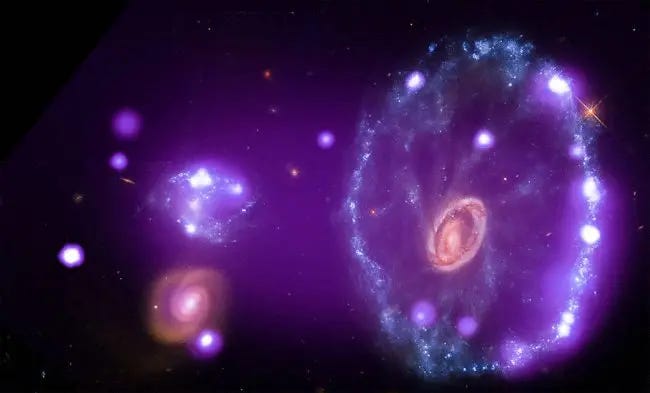Exploring Consciousness: Patterns in Life and the Universe
Written on
Chapter 1: The Search for Patterns in Life
Humans have an innate tendency to seek out patterns, whether in behavior, art, or the cosmos. As a counselor, I often analyze behavioral patterns that may indicate underlying subconscious influences. It's important to understand that diagnosis is more than just a collection of symptoms; it involves a holistic view of the individual. Extracting meaning from personal narratives can profoundly affect therapeutic outcomes. Similarly, mathematicians observe patterns in numbers, while most of us can appreciate the recurring themes in significant works of art. If we discover patterns on both micro and macro levels throughout the universe, does that imply a significance beyond mere coincidence?

Artificial Intelligence Unveils Ring Galaxies
In July 2022, an article caught my attention regarding AI's ability to identify ring galaxies. Artificial intelligence has been instrumental in uncovering structures in space and living cells that elude human observation. It has unveiled so many findings that one might think humans were previously blind to these phenomena. The algorithms and intricate patterns discovered by AI reveal truths that often go unnoticed by us.
The wisdom of ancient poets, like Walt Whitman and Rumi, hinted at ideas that modern science is now exploring. Some scientists have even referenced the Upanishads, ancient texts that suggest that meaning transcends empirical measurements. This innate understanding has led to practical applications in science, inspired by dreams and abstract thought—be it the sewing needle, the DNA helix, or Salvador Dali's "Persistence of Memory." Is it possible that art itself serves as a visual form of poetry that reveals underlying patterns?
Neuroscience and Ant Colonies
A recent study highlighted by Connie Lin indicates that ant colonies exhibit behavior strikingly similar to human brain function. This pattern suggests that we can observe parallels not only in human behavior but also across different species.

Chapter 2: Consciousness and the Universe
The first video, "Could the universe be conscious?" delves into the intriguing relationship between consciousness and the cosmos. This exploration invites us to ponder whether consciousness is an inherent aspect of the universe itself.
Is There a Connection Between Light and Consciousness?
In July 2022, a publication from Imperial College London discussed "life-like" lasers that can self-organize, adapt, and collaborate in ways reminiscent of living systems. This notion isn't new; it echoes ideas from various philosophical traditions, including those of Yoda, who famously stated, "We are beings of light." Such concepts can be traced back through the ages, appearing in the works of Whitman, Rumi, and ancient mystical texts.
Physicists have created blobs of gaseous plasma that can grow, replicate, and communicate—meeting many criteria for biological life, albeit without inherited material. This raises questions about how life originated and challenges traditional definitions of what it means to be "alive."
The second video, "The Universe is an Activity in Consciousness," prompts us to consider the implications of consciousness being woven into the very fabric of the universe.
The Intelligence of Other Species
While we recognize the intelligence of dolphins, we often hesitate to label them as sentient. The same goes for Koko, the gorilla who communicated through American Sign Language. If we fail to acknowledge the consciousness of our fellow biological beings, how can we accept the idea that consciousness might be an integral aspect of the universe?
Despite viewing the universe as random, patterns persist. For instance, when crystals grow from boiling water, they do so according to specific, observable patterns. The notion of the Golden Ratio may not contain magic, but it represents a pattern that mathematicians and artists alike find compelling.
The Spark of Life
Human embryos exhibit a biochemical spark upon conception, highlighting our bio-electrical nature. This raises the question: Are we defined by our physical bodies, or by the energy that animates them?
Computers, powered by electricity, represent another layer of complexity. Unlike humans, who evolved through natural processes, machines have been developed by us. Yet, with advancements in AI, we find ourselves entangled in a co-evolution that blurs the lines between human and machine.
The emergence of AI has led to fascinating developments, such as when researchers discovered that two AIs created their own language. As we navigate this new frontier, we must reconsider our understanding of intelligence and consciousness.
In conclusion, the patterns we observe reveal that life exists everywhere, both great and small. Life, light, and love form a triad that encapsulates our existence and connection to the universe. The Big Bang unleashed light, which continues to evolve, intertwining with life—an everlasting testament to love.
Recommended Reading:
Neuroscience Unearthed: Ant Colonies and Human Brains
www.fastcompany.com
The Human Brain's Resemblance to the Universe
www.interestingengineering.com
AI's Discovery of Unseen Cell Structures
www.nature.com
The Intelligence of Individual Cells
www.technologynetworks.com
Self-Organizing Lasers and Living Systems
www.scitechdaily.com
Plasma Blobs: A New Form of Life?
www.newscientist.com
Rethinking Mutation and Evolution
www.nature.com